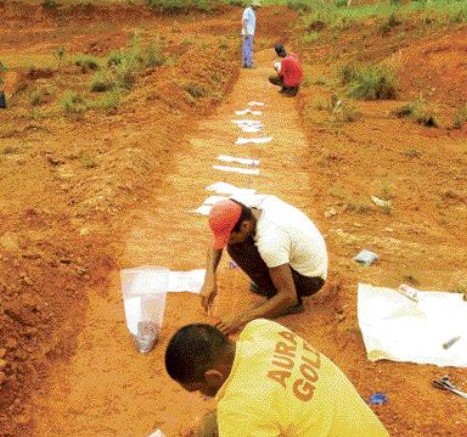Few garimpeiros are seen these days near Aura Gold’s (ORA-T, AUGIF-O) newly acquired Cumaru gold project in north-central Brazil’s Para state — a dramatic contrast with the scene during a 1980s rush, when they came in droves to find gold.
Until now, the land has been largely untouched by modern exploration techniques, improving the potential for Aura Gold to make new discoveries.
“It’s very exciting,” says Victor Bradley, president, CEO and a director of Aura Gold. “It gives you the spirit of the pioneers and it means doing genuinely creative work.”
But Bradley admits that the real prospectors were the garimpeiros, small-scale independent miners, viewed by some as illegal, who hauled sacks of gravel from man-dug pits in hopes of finding gold. It is estimated that garimpeiros have produced up to 60 million oz. gold, or about 60% of Brazil’s total gold production; half of that has come from Para state over the last 30 years.
“We find it romantic, though some Brazilians don’t,” Bradley says.
The company recently began a 3,000-metre drill program at the Cumaru and Graduas gold properties, which make up the 360-sq.-km Cumaru project in southern Carajas province. Drill holes at Cumaru will be no deeper than 200 metres. Garimpeiros have dug holes up to about 20 metres deep, but were unable to go deeper because of the water table.
Aura Gold, first listed on the TSX in July, began as a concept in October 2005 when Bradley learned of some properties through the connections he’d made at Yamana Gold (yri-t, auy-x), of which he is currently chair. Yamana produced more than 400,000 oz. during 2006 and is aiming for 1 million oz. annually by 2008.
Located along a southern Archean-age greenstone belt, Cumaru is the second-largest garimpeiro gold district in Carajas. Discovered in 1980, the Cumaru area has officially produced 1.5 million oz. gold, but the actual figure is thought to be twice that. Limited drilling has been done at Graduas, where there is a small open-pit mine.
Aura Gold also has two other properties in Para state: the 1,250-sq.-km Inaja greenstone belt and the 4,330-sq.-km North Carajas claims.
Inaja, 90 km south of Cumaru, is also known for garimpeiro gold production in the 1980s. It’s located on the southernmost Archean-age greenstone belt in the region and forms a 100-km-long arc.
“Most Brazilians haven’t focused on greenstone belts, whereas North Americans see them as being relevant targets,” says Steve Dawson, a geologist and vice-president of corporate development at Aura Gold.
North Carajas has been explored for nickel, copper and diamonds, but has not been drill tested. Gold occurrences are known throughout the Archean and Early Proterozoic rock sequences of the region. Some of Aura Gold’s claims are near the world-class Salabo copper-gold deposit, owned by Companhia Vale do Rio Doce (rio-n) and Serra Pelada, where 1.3 million oz. gold was mined up to 1994.
Aura Gold acquired Cumaru from Yamana Gold and Caraja from Santa Elina Mining, a 10% shareholder of Yamana.
Inaja was acquired through nine separate arm’s-length agreements with various landowners.
Dawson says that heavy labour done by the garimpeiros to mine surface gold isn’t a guarantee of gold below, but it’s a good sign.
“Garimpeiros don’t just do it for the sake of it; that’s how they make their living.”
So far, grab samples from the Graduas mine have been as high as 65.3 grams gold per tonne while grab samples from Cumaru’s Divino target yielded values of 102.5 and 27.2 grams gold. As well, grab and chip samples taken from Axixa target, OP-2 and OP-3, assayed 1.2 grams gold over 2 metres and 2.3 grams gold over 3 metres.
Dawson says the company will not be putting out results on a hole-by-hole basis because so far only 5 of 360 sq. km have been examined.
“We’re not interested in hyping the market,” he says.
Yet to come is regional reconnaissance sampling and a detailed evaluation of the project through geographic information system (GIS) mapping.
Because of its history, Cumaru looks like the “crown jewel,” says Bradley, but he thinks Inaja is going to take first place because of its potential for copper, nickel and iron, as well as gold.
While drilling and exploration continues, Bradley says Aura Gold will keep its eyes peeled for other acquisitions. The company’s focus is Brazil, but it’s open to properties elsewhere in South America.
“Anything I come across (in South America) would go to Aura Gold,” Bradley says. “I’m not interested in starting another company.”
The junior raised $10 million during the first half of 2006 before its IPO, with about $7.5 million currently in the treasury.
Bradley has hopes of keeping Aura Gold through the prefeasibility stage by getting equity financing in stages, though he noted that it’s currently an era of consolidation. If the price is right and it’s fair to shareholders, a partnership proposal couldn’t be rejected, he says.


Be the first to comment on "Aura Gold follows trail of Brazil’s garimpeiros"